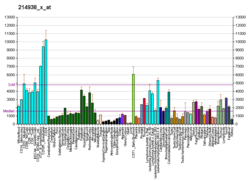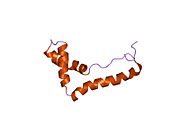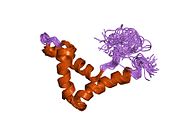HMGB1
HMGB1고이동성 그룹 박스 1 단백질은 고이동성 그룹 단백질 1(HMG-1)과 암포테린으로도 알려져 있으며, 인체 내에서 HMGB1 [3][4]유전자에 의해 암호화되는 단백질이다.
HMG-1은 높은 모빌리티 그룹에 속하며 HMG 박스 도메인을 포함합니다.
기능.
히스톤과 마찬가지로 HMGB1은 가장 중요한 염색질 단백질 중 하나이다.핵에서 HMGB1은 뉴클레오솜, 전사인자, [5]히스톤과 상호작용한다.이 핵단백질은 DNA를 구성하고 [6]전사를 조절한다.결합 후 HMGB1은[7] DNA를 구부려 다른 단백질의 결합을 촉진한다.HMGB1은 많은 전사인자와의 상호작용에서 많은 유전자의 전사를 지원한다.그것은 또한 채워진 DNA를 느슨하게 하고 염색질을 개조하기 위해 뉴클레오솜과 상호작용한다.코어 히스톤과의 접촉은 뉴클레오솜의 구조를 변화시킨다.
핵에 HMGB1이 있는지 여부는 번역 후 수정에 따라 달라집니다.단백질이 아세틸화되지 않으면 핵에 머무르지만 리신 잔기에 대한 과아세틸화는 단백질이 세포로 [6]전이되는 원인이 된다.
HMGB1은 V(D)J [8]재결합 중에 RAG 핵산가수분해효소가 쌍으로 이루어진 복합체를 형성하는데 중요한 역할을 하는 것으로 나타났다.
염증에서의 역할
HMGB1은 면역 세포(대식세포, 단구, 수지상 세포 등)에 의해 리더리스 분비 [6]경로를 통해 분비된다.활성화된 대식세포와 단구들은 [9]염증의 사이토카인 매개체로서 HMGB1을 분비한다.HMGB1을 중화시키는 항체는 관절염, 대장염, 허혈, 패혈증, 내독소혈증, 전신성 홍반성 [citation needed]루푸스 중 손상과 조직 손상에 대한 보호를 제공합니다.염증과 손상의 메커니즘은 대식세포 사이토카인 방출의 HMGB1 의존적 활성화를 매개하는 TLR2 및 TLR4에 대한 결합으로 구성된다.이렇게 하면 HMGB1이 멸균 반응과 감염성 염증 [10][11]반응의 교차점에 배치됩니다.
PARP1에 의한 HMGB1의 ADP 리보실화는 아포토시스 세포의 제거를 억제하여 [12]염증을 지속시킨다.HMGB1에 의한 TLR4 결합 또는 LPS(리포다당류)는 PARP1에 의한 HMGB1의 ADP-리보실화를 유지함으로써 [12]염증의 증폭 루프가 된다.
HMGB1은 DNA 백신 [13]보조제로 제안되었다.종양 세포에서 방출된 HMGB1은 골수 유래 GBM 침투 DC에서 [14]Toll-like receptor 2(TLR2) 시그널링을 활성화함으로써 항종양 면역 반응을 매개하는 것으로 입증되었다.
상호 작용
HMGB1은 p53과 [15][16]상호 작용해야 합니다.
HMGB1은 DNA에 결합하는 핵단백질이며 구조적인 크로마틴 결합 인자로 작용한다.또한 세포 외 형성이 염증 수용체 RAGE(고급 당화 최종 생성물 수용체)와 Toll-like 수용체(TLR)와 결합할 수 있는 세포에서 방출될 수 있다.세포로부터의 방출은 두 가지 뚜렷한 과정을 수반하는 것으로 보인다: 이 경우 세포막이 투과되고 세포 내 구성 요소가 세포 밖으로 확산될 수 있는 괴사, 그리고 NF-δB를 통한 신호 전달에 의해 유도되는 어떤 형태의 활성 또는 촉진된 분비.HMGB1은 또한 세포 내에서 증가하는 ROS와 같은 스트레스 조건 하에서 세포로 이동한다.이러한 조건에서 HMGB1은 베클린-1과의 상호작용을 통해 자가파지를 유지함으로써 세포 생존을 촉진한다.그것은 주로 항아포토시스 단백질로 여겨진다.
HMGB1은 TLR 리간드 및 사이토카인과 상호작용할 수 있으며 TLR2, TLR4, [17]RAGE를 포함한 다중 표면 수용체를 통해 세포를 활성화한다.
TLR4를 통한 상호작용
HMGB1의 일부 작용은 톨 유사 수용체(TLR)를 [18]통해 매개된다.HMGB1과 TLR4 사이의 상호작용은 NF-γB의 상향 조절을 초래하여 사이토카인의 생산과 방출을 증가시킨다.HMGB1은 또한 호중구의 TLR4와 상호작용하여 NADPH 산화효소에 [6][19]의한 활성산소 종의 생산을 촉진할 수 있다.HMGB1-LPS 복합체는 TLR4를 활성화하고 어댑터 단백질(MyD88 및 기타)의 결합을 유발하여 신호 전달 및 다양한 신호 캐스케이드 활성화를 유도한다.이 시그널링의 다운스트림 효과는 MAPK와 NF-δB를 활성화하여 사이토카인과 [20][21]같은 염증 분자의 생성을 일으킨다.
임상적 의의
HMGB1은 SARS-CoV-2 감염에 의한 염증을 줄이기 위한 매개체로서 [22]암 치료의 대상으로 제안되었다.[23] COVID-19 이후의 [24]상태를 나타내는 바이오마커로 사용됩니다.
신경변성성성 척추신경실조증 타입 1(SCA1)은 아탁신 1 유전자의 돌연변이에 의해 발생한다.SCA1의 마우스 모델에서 돌연변이 아탁신1 단백질이 뉴런의 [25]미토콘드리아에서 HMGB1의 환원 또는 억제를 매개하였다.HMGB1은 DNA 손상 복구에 필수적인 DNA 구조 변화를 조절합니다.SCA1 마우스 모델에서는 HMGB1 유전자를 가진 도입 바이러스 벡터에 의한 HMGB1 단백질의 과잉 발현에 의해 미토콘드리아 DNA 손상 복구가 촉진되어 SCA1 마우스의 신경병리 및 운동결함이 개선되고 [25]수명도 연장되었다.따라서 HMGB1 기능의 장애는 SCA1의 병인에 중요한 역할을 하는 것으로 보입니다.
최근 한 연구는 HMGB1의 상승된 수치와 고기능 자폐 스펙트럼 장애(ASD)를 가진 미의학 아동의 세부사항과 체계화 사이의 연관성에 대한 증거를 제공했으며, HMGB1에 의해 매개되는 염증 과정이 인지 진행을 조절하는 신경생물학적 메커니즘의 교란에 역할을 할 수 있다는 것을 시사했다.ASD의 [26]SS.본 연구에서 ASD를 가진 아동의 HMGB1 혈청 농도는 전형적으로 발달하는 아동의 HMGB1 혈청 농도보다 유의미하게 높았다.또한, HMGB1 혈청 농도는 ASD [27]그룹의 상세 점수 및 체계화 지수(SQ) 총 점수에 대한 자폐 지수(AQ) 주의와 양의 상관관계가 있었다.그러나 어린이에 대한 포괄적인 증거는 제한적이며, 이는 HMGB1과 ASD의 핵심 특징을 연결하는 가능한 메커니즘을 이해하기 위한 심층 연구의 필요성을 강조한다.그럼에도 불구하고, HMGB1은 염증 과정과 몇몇 자폐 특성 사이의 연관성을 설명하는 신뢰할 수 있는 염증 지표가 될 수 있으며, 따라서 이 신경 발달 장애에서 가능한 치료 표적이 될 수 있다고 제안되었다.
레퍼런스
- ^ a b c GRCh38: 앙상블 릴리즈 89: ENSG00000189403 - 앙상블, 2017년 5월
- ^ "Human PubMed Reference:". National Center for Biotechnology Information, U.S. National Library of Medicine.
- ^ Ferrari S, Finelli P, Rocchi M, Bianchi ME (July 1996). "The active gene that encodes human high mobility group 1 protein (HMG1) contains introns and maps to chromosome 13". Genomics. 35 (2): 367–71. doi:10.1006/geno.1996.0369. PMID 8661151.
- ^ Chou DK, Evans JE, Jungalwala FB (April 2001). "Identity of nuclear high-mobility-group protein, HMG-1, and sulfoglucuronyl carbohydrate-binding protein, SBP-1, in brain". Journal of Neurochemistry. 77 (1): 120–31. doi:10.1046/j.1471-4159.2001.t01-1-00209.x. PMID 11279268.
- ^ Bianchi ME, Agresti A (October 2005). "HMG proteins: dynamic players in gene regulation and differentiation". Current Opinion in Genetics & Development. 15 (5): 496–506. doi:10.1016/j.gde.2005.08.007. PMID 16102963.
- ^ a b c d Klune JR, Dhupar R, Cardinal J, Billiar TR, Tsung A (2008). "HMGB1: endogenous danger signaling". Molecular Medicine. 14 (7–8): 476–84. doi:10.2119/2008-00034.Klune. PMC 2323334. PMID 18431461.
- ^ Murugesapillai D, McCauley MJ, Maher LJ, Williams MC (February 2017). "Single-molecule studies of high-mobility group B architectural DNA bending proteins". Biophysical Reviews. 9 (1): 17–40. doi:10.1007/s12551-016-0236-4. PMC 5331113. PMID 28303166.
- ^ Ciubotaru M, Trexler AJ, Spiridon LN, Surleac MD, Rhoades E, Petrescu AJ, Schatz DG (February 2013). "RAG and HMGB1 create a large bend in the 23RSS in the V(D)J recombination synaptic complexes". Nucleic Acids Research. 41 (4): 2437–54. doi:10.1093/nar/gks1294. PMC 3575807. PMID 23293004.
- ^ Wang H, Bloom O, Zhang M, Vishnubhakat JM, Ombrellino M, Che J, Frazier A, Yang H, Ivanova S, Borovikova L, Manogue KR, Faist E, Abraham E, Andersson J, Andersson U, Molina PE, Abumrad NN, Sama A, Tracey KJ (July 1999). "HMG-1 as a late mediator of endotoxin lethality in mice". Science. 285 (5425): 248–51. doi:10.1126/science.285.5425.248. PMID 10398600.
- ^ Yang H, Hreggvidsdottir HS, Palmblad K, Wang H, Ochani M, Li J, Lu B, Chavan S, Rosas-Ballina M, Al-Abed Y, Akira S, Bierhaus A, Erlandsson-Harris H, Andersson U, Tracey KJ (June 2010). "A critical cysteine is required for HMGB1 binding to Toll-like receptor 4 and activation of macrophage cytokine release". Proceedings of the National Academy of Sciences of the United States of America. 107 (26): 11942–7. Bibcode:2010PNAS..10711942Y. doi:10.1073/pnas.1003893107. PMC 2900689. PMID 20547845.
- ^ Yang H, Tracey KJ (2010). "Targeting HMGB1 in inflammation". Biochimica et Biophysica Acta (BBA) - Gene Regulatory Mechanisms. 1799 (1–2): 149–56. doi:10.1016/j.bbagrm.2009.11.019. PMC 4533842. PMID 19948257.
- ^ a b Pazzaglia S, Pioli C (2019). "Multifaceted Role of PARP-1 in DNA Repair and Inflammation: Pathological and Therapeutic Implications in Cancer and Non-Cancer Diseases". Cells. 9 (1): 41. doi:10.3390/cells9010041. PMC 7017201. PMID 31877876.
- ^ Fagone P, Shedlock DJ, Bao H, Kawalekar OU, Yan J, Gupta D, Morrow MP, Patel A, Kobinger GP, Muthumani K, Weiner DB (November 2011). "Molecular adjuvant HMGB1 enhances anti-influenza immunity during DNA vaccination". Gene Therapy. 18 (11): 1070–7. doi:10.1038/gt.2011.59. PMC 4141626. PMID 21544096.
- ^ Curtin JF, Liu N, Candolfi M, Xiong W, Assi H, Yagiz K, Edwards MR, Michelsen KS, Kroeger KM, Liu C, Muhammad AK, Clark MC, Arditi M, Comin-Anduix B, Ribas A, Lowenstein PR, Castro MG (January 2009). "HMGB1 mediates endogenous TLR2 activation and brain tumor regression". PLOS Medicine. 6 (1): e10. doi:10.1371/journal.pmed.1000010. PMC 2621261. PMID 19143470.
- ^ Imamura T, Izumi H, Nagatani G, Ise T, Nomoto M, Iwamoto Y, Kohno K (March 2001). "Interaction with p53 enhances binding of cisplatin-modified DNA by high mobility group 1 protein". The Journal of Biological Chemistry. 276 (10): 7534–40. doi:10.1074/jbc.M008143200. PMID 11106654.
- ^ Dintilhac A, Bernués J (March 2002). "HMGB1 interacts with many apparently unrelated proteins by recognizing short amino acid sequences". The Journal of Biological Chemistry. 277 (9): 7021–8. doi:10.1074/jbc.M108417200. PMID 11748221.
- ^ Sims GP, Rowe DC, Rietdijk ST, Herbst R, Coyle AJ (2010). "HMGB1 and RAGE in inflammation and cancer". Annual Review of Immunology. 28: 367–88. doi:10.1146/annurev.immunol.021908.132603. PMID 20192808.
- ^ Ibrahim ZA, Armour CL, Phipps S, Sukkar MB (December 2013). "RAGE and TLRs: relatives, friends or neighbours?". Molecular Immunology. 56 (4): 739–44. doi:10.1016/j.molimm.2013.07.008. PMID 23954397.
- ^ Park JS, Gamboni-Robertson F, He Q, Svetkauskaite D, Kim JY, Strassheim D, Sohn JW, Yamada S, Maruyama I, Banerjee A, Ishizaka A, Abraham E (March 2006). "High mobility group box 1 protein interacts with multiple Toll-like receptors". American Journal of Physiology. Cell Physiology. 290 (3): C917-24. doi:10.1152/ajpcell.00401.2005. PMID 16267105.
- ^ Bianchi ME (September 2009). "HMGB1 loves company". Journal of Leukocyte Biology. 86 (3): 573–6. doi:10.1189/jlb.1008585. PMID 19414536.
- ^ Hreggvidsdóttir HS, Lundberg AM, Aveberger AC, Klevenvall L, Andersson U, Harris HE (March 2012). "High mobility group box protein 1 (HMGB1)-partner molecule complexes enhance cytokine production by signaling through the partner molecule receptor". Molecular Medicine. 18 (2): 224–30. doi:10.2119/molmed.2011.00327. PMC 3320135. PMID 22076468.
- ^ Lotze MT, DeMarco RA (December 2003). "Dealing with death: HMGB1 as a novel target for cancer therapy". Current Opinion in Investigational Drugs. 4 (12): 1405–1409. PMID 14763124.
- ^ Andersson U, Ottestad W, Tracey KJ (May 2020). "Extracellular HMGB1: a therapeutic target in severe pulmonary inflammation including COVID-19?". Molecular Medicine. 26 (1): 42. doi:10.1186/s10020-020-00172-4. PMC 7203545. PMID 32380958.
- ^ Ryan FJ, Hope CM, Masavuli MG, Lynn MA, Mekonnen ZA, Yeow AE, et al. (January 2022). "Long-term perturbation of the peripheral immune system months after SARS-CoV-2 infection". BMC Medicine. 20 (1): 26. doi:10.1186/s12916-021-02228-6. PMC 8758383. PMID 35027067.
- ^ a b Ito H, Fujita K, Tagawa K, Chen X, Homma H, Sasabe T, Shimizu J, Shimizu S, Tamura T, Muramatsu S, Okazawa H (January 2015). "HMGB1 facilitates repair of mitochondrial DNA damage and extends the lifespan of mutant ataxin-1 knock-in mice". EMBO Molecular Medicine. 7 (1): 78–101. doi:10.15252/emmm.201404392. PMC 4309669. PMID 25510912.
- ^ Makris G, Chouliaras G, Apostolakou F, Papageorgiou C, Chrousos G, Papassotiriou I, Pervanidou P (2021). "Increased serum concentrations of high mobility group box 1 (HMGB1) protein in children with Autism Spectrum Disorder". Children. 8 (6): 478. doi:10.3390/children8060478. PMC 8228126. PMID 34198762.
- ^ Makris G, Chouliaras G, Apostolakou F, Papageorgiou C, Chrousos G, Papassotiriou I, Pervanidou P (2021). "Increased serum concentrations of high mobility group box 1 (HMGB1) protein in children with Autism Spectrum Disorder". Children. 8 (6): 478. doi:10.3390/children8060478. PMC 8228126. PMID 34198762.
추가 정보
- Thomas JO, Travers AA (March 2001). "HMG1 and 2, and related 'architectural' DNA-binding proteins". Trends in Biochemical Sciences. 26 (3): 167–74. doi:10.1016/S0968-0004(01)01801-1. PMID 11246022.
- Andersson U, Erlandsson-Harris H, Yang H, Tracey KJ (December 2002). "HMGB1 as a DNA-binding cytokine". Journal of Leukocyte Biology. 72 (6): 1084–91. PMID 12488489.
- Wu H, Wu T, Hua W, Dong X, Gao Y, Zhao X, Chen W, Cao W, Yang Q, Qi J, Zhou J, Wang J (March 2015). "PGE2 receptor agonist misoprostol protects brain against intracerebral hemorrhage in mice". Neurobiology of Aging. 36 (3): 1439–50. doi:10.1016/j.neurobiolaging.2014.12.029. PMC 4417504. PMID 25623334.
- Erlandsson Harris H, Andersson U (June 2004). "Mini-review: The nuclear protein HMGB1 as a proinflammatory mediator". European Journal of Immunology. 34 (6): 1503–12. doi:10.1002/eji.200424916. PMID 15162419.
- Jiang W, Pisetsky DS (January 2007). "Mechanisms of Disease: the role of high-mobility group protein 1 in the pathogenesis of inflammatory arthritis". Nature Clinical Practice. Rheumatology. 3 (1): 52–8. doi:10.1038/ncprheum0379. PMID 17203009. S2CID 428632.
- Ellerman JE, Brown CK, de Vera M, Zeh HJ, Billiar T, Rubartelli A, Lotze MT (May 2007). "Masquerader: high mobility group box-1 and cancer". Clinical Cancer Research. 13 (10): 2836–48. doi:10.1158/1078-0432.CCR-06-1953. PMID 17504981.
- Fossati S, Chiarugi A (2007). "Relevance of high-mobility group protein box 1 to neurodegeneration". International Review of Neurobiology. 82: 137–48. doi:10.1016/S0074-7742(07)82007-1. ISBN 9780123739896. PMID 17678959.
- Parkkinen J, Rauvala H (September 1991). "Interactions of plasminogen and tissue plasminogen activator (t-PA) with amphoterin. Enhancement of t-PA-catalyzed plasminogen activation by amphoterin". The Journal of Biological Chemistry. 266 (25): 16730–5. doi:10.1016/S0021-9258(18)55362-X. PMID 1909331.
- Wen L, Huang JK, Johnson BH, Reeck GR (February 1989). "A human placental cDNA clone that encodes nonhistone chromosomal protein HMG-1". Nucleic Acids Research. 17 (3): 1197–214. doi:10.1093/nar/17.3.1197. PMC 331735. PMID 2922262.
- Bernués J, Espel E, Querol E (May 1986). "Identification of the core-histone-binding domains of HMG1 and HMG2". Biochimica et Biophysica Acta (BBA) - Gene Structure and Expression. 866 (4): 242–51. doi:10.1016/0167-4781(86)90049-7. PMID 3697355.
- Ge H, Roeder RG (June 1994). "The high mobility group protein HMG1 can reversibly inhibit class II gene transcription by interaction with the TATA-binding protein". The Journal of Biological Chemistry. 269 (25): 17136–40. doi:10.1016/S0021-9258(17)32531-0. PMID 8006019.
- Parkkinen J, Raulo E, Merenmies J, Nolo R, Kajander EO, Baumann M, Rauvala H (September 1993). "Amphoterin, the 30-kDa protein in a family of HMG1-type polypeptides. Enhanced expression in transformed cells, leading edge localization, and interactions with plasminogen activation". The Journal of Biological Chemistry. 268 (26): 19726–38. doi:10.1016/S0021-9258(19)36575-5. PMID 8366113.
- Zappavigna V, Falciola L, Helmer-Citterich M, Mavilio F, Bianchi ME (September 1996). "HMG1 interacts with HOX proteins and enhances their DNA binding and transcriptional activation". The EMBO Journal. 15 (18): 4981–91. doi:10.1002/j.1460-2075.1996.tb00878.x. PMC 452236. PMID 8890171.
- Xiang YY, Wang DY, Tanaka M, Suzuki M, Kiyokawa E, Igarashi H, Naito Y, Shen Q, Sugimura H (February 1997). "Expression of high-mobility group-1 mRNA in human gastrointestinal adenocarcinoma and corresponding non-cancerous mucosa". International Journal of Cancer. 74 (1): 1–6. doi:10.1002/(SICI)1097-0215(19970220)74:1<1::AID-IJC1>3.0.CO;2-6. PMID 9036861.
- Rasmussen RK, Ji H, Eddes JS, Moritz RL, Reid GE, Simpson RJ, Dorow DS (1997). "Two-dimensional electrophoretic analysis of human breast carcinoma proteins: mapping of proteins that bind to the SH3 domain of mixed lineage kinase MLK2". Electrophoresis. 18 (3–4): 588–98. doi:10.1002/elps.1150180342. PMID 9150946. S2CID 37336552.
- Jayaraman L, Moorthy NC, Murthy KG, Manley JL, Bustin M, Prives C (February 1998). "High mobility group protein-1 (HMG-1) is a unique activator of p53". Genes & Development. 12 (4): 462–72. doi:10.1101/gad.12.4.462. PMC 316524. PMID 9472015.
- Milev P, Chiba A, Häring M, Rauvala H, Schachner M, Ranscht B, Margolis RK, Margolis RU (March 1998). "High affinity binding and overlapping localization of neurocan and phosphacan/protein-tyrosine phosphatase-zeta/beta with tenascin-R, amphoterin, and the heparin-binding growth-associated molecule". The Journal of Biological Chemistry. 273 (12): 6998–7005. doi:10.1074/jbc.273.12.6998. PMID 9507007.
- Nagaki S, Yamamoto M, Yumoto Y, Shirakawa H, Yoshida M, Teraoka H (May 1998). "Non-histone chromosomal proteins HMG1 and 2 enhance ligation reaction of DNA double-strand breaks". Biochemical and Biophysical Research Communications. 246 (1): 137–41. doi:10.1006/bbrc.1998.8589. PMID 9600082.
- Claudio JO, Liew CC, Dempsey AA, Cukerman E, Stewart AK, Na E, Atkins HL, Iscove NN, Hawley RG (May 1998). "Identification of sequence-tagged transcripts differentially expressed within the human hematopoietic hierarchy". Genomics. 50 (1): 44–52. doi:10.1006/geno.1998.5308. PMID 9628821.
- Boonyaratanakornkit V, Melvin V, Prendergast P, Altmann M, Ronfani L, Bianchi ME, Taraseviciene L, Nordeen SK, Allegretto EA, Edwards DP (August 1998). "High-mobility group chromatin proteins 1 and 2 functionally interact with steroid hormone receptors to enhance their DNA binding in vitro and transcriptional activity in mammalian cells". Molecular and Cellular Biology. 18 (8): 4471–87. doi:10.1128/mcb.18.8.4471. PMC 109033. PMID 9671457.
- Wu H, Wu T, Han X, Wan J, Jiang C, Chen W, Lu H, Yang Q, Wang J (January 2017). "Cerebroprotection by the neuronal PGE2 receptor EP2 after intracerebral hemorrhage in middle-aged mice". Journal of Cerebral Blood Flow and Metabolism. 37 (1): 39–51. doi:10.1177/0271678X15625351. PMC 5363749. PMID 26746866.
- Jiao Y, Wang HC, Fan SJ (December 2007). "Growth suppression and radiosensitivity increase by HMGB1 in breast cancer". Acta Pharmacologica Sinica. 28 (12): 1957–67. doi:10.1111/j.1745-7254.2007.00669.x. PMID 18031610.
- Andersson U, Ottestad W, Tracey KJ (May 2020). "Extracellular HMGB1: a therapeutic target in severe pulmonary inflammation including COVID-19?". Mol Med. 26 (1): 42(2020). doi:10.1186/s10020-020-00172-4. PMC 7203545. PMID 32380958.
외부 링크
- HMGB1+단백질+미국국립의학도서관 의학 과목 제목(MeSH)
- 췌장암 연구와 HMGB1 신호 경로
- PDBe-KB는 PDB for Human High Mobility Group Protein B1(HMGB1)에서 사용 가능한 모든 구조 정보의 개요를 제공합니다.
- PDBe-KB는 PDB for Rat High 모빌리티 그룹 단백질 B1(HMGB1)에서 사용 가능한 모든 구조 정보의 개요를 제공합니다.

















